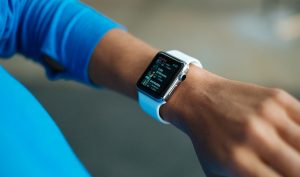
In today’s fast-paced world, smart wearables are key for understanding our health. They range from advanced smartwatches to simple fitness trackers. These devices use new technology to track and analyze our health.
They are made with materials like polyethylene terephthalate (PET) and polydimethylsiloxane (PDMS). These materials are flexible, yet strong and light. This makes the world of digital health wearables always changing.
Using smart health devices shows our need for easy health monitoring. We’re turning to technology like the Internet of Things (IoT) more and more. This means we get real-time data and analysis from these devices.
Studies show these features help patients get more involved in their health. They also lead to better healthcare. With more people in the U.S. using smartwatches, it’s clear we’re adopting these tech advances to improve our health monitoring.
Understanding Smart Wearables for Health Monitoring
Smart wearables have changed how we manage our health. They bring technology into our daily lives, giving us insights into our health. This lets us track important health signals like heart rate and blood pressure.
Definition and Overview
Wearable health technology means devices we wear on our bodies. They collect and send out health info. This helps us keep track of things like heart rate and oxygen levels. With more people wanting real-time health info, these devices are getting popular.
Types of Wearable Technology
There are many kinds of wearable tech for different health needs. Here are some common ones:
- Fitness Trackers: These track how active you are, like steps taken and calories burned.
- Smartwatches: These do more than just tell time. They help track your health and connect with apps for more info.
- Medical Devices: These are made for specific health needs, like tracking blood pressure or sleep.
- Multifunctional Devices: These advanced gadgets can track many health signals, showing how far wearable tech has come.
As technology gets better, we’ll see more ways to improve health monitoring. This could lead to better health care and early help for health issues.
Benefits of Wearable Health Technology
Wearable health technology brings many benefits to how we manage our health. It makes tracking our health easy and simple. In the last year, more people started using these devices, helping us reach our health goals better than ever.
Convenience and Accessibility
Today’s health gadgets are super convenient. You can wear them as smartwatches or fitness trackers. 65% of people find them really helpful for tracking their health. They make it easy to keep an eye on our health without the hassle of manual tracking.
Real-Time Insights
Getting real-time data is a big deal with wearable health tech. We can see our steps, heart rate, and sleep right away. This info helps us make quick changes to our habits. 80% of users say they’re moving more thanks to these updates.
This instant feedback helps us stay on top of our health. It lets us tackle problems early and keeps us motivated.
Encouragement of Active Lifestyles
Wearable devices really push us to be more active. Seeing our health stats, like how much we move and sleep, motivates us to be healthier. Studies show a 30% jump in catching health issues early with these tools.
By using these devices regularly, we help cut down on sitting too much. This leads to better health overall, both physically and mentally.
Smart Wearables for Health Monitoring
Exploring smart health wearables is exciting. It’s important to know what makes them tick. These devices help us keep an eye on our health and give us valuable insights. This can change how we think about staying healthy.
Key Features to Look For
When picking wearable tech for health, look for certain key features. These make them easy to use and effective:
- Sensor Accuracy: Good sensors give us accurate health data.
- Data Analytics: Advanced analytics make it easier to understand the data. This helps us make better health choices.
- Compatibility: It’s important that devices work well with phones and other health tools.
- Usability: An easy-to-use interface means we can quickly get to our health info.
Popular Wearable Devices
Many devices have become popular for health tracking. Each one is made for different health needs. Here are some well-known ones:
| Device | Key Features | Brand |
|---|---|---|
| Apple Watch Series 8 | Heart rate monitoring, ECG capabilities, fall detection | Apple |
| Fitbit Charge 6 | Menstrual cycle tracking, fitness coaching | Fitbit |
| KardiaMobile | Portable ECG tracking | AliveCor |
| Ava Bracelet | Fertility tracking, sleep monitoring | Ava |
| WHOOP Strap | Sleep and recovery monitoring | WHOOP |
Integration with Health Systems
Linking health devices with health systems makes sharing data easier. This helps doctors and patients work together better. For example, remote patient monitoring lets doctors keep track of patients’ health easily.
The market for smart health wearables is growing fast. We can expect more new solutions soon. With technology getting better, the future looks bright for those wanting to keep an eye on their health with smart wearables.
Conclusion
Smart wearables for health monitoring are changing how we manage our health. They blend convenience with advanced analytics, letting us watch over our health closely. The global market for these devices is expected to hit $60 billion by 2026, showing how much people trust them for health care.
These devices have a big impact. People using fitness trackers or smartwatches have seen a 50% boost in their health habits. This shows how real-time data helps us stay on track with our health. Plus, they could save the healthcare system up to $300 billion a year by 2024, showing their value in health care.
As we move forward with this technology, we must tackle issues like data privacy and accuracy. But, we see a future where real-time monitoring and AI are common. By using smart wearables now, we’re taking a big step towards better health. We’re also making health care easier for everyone.





